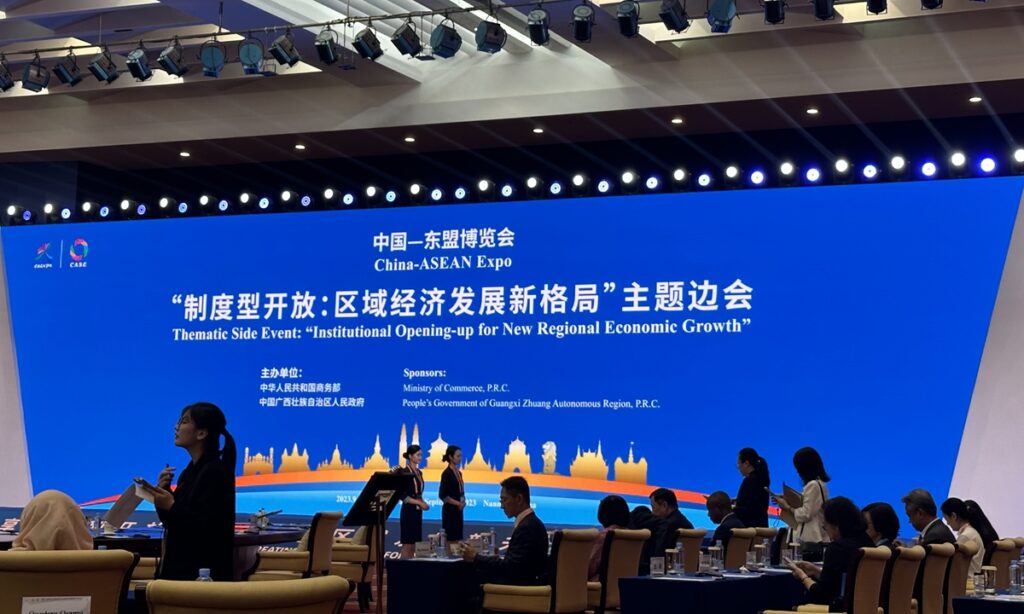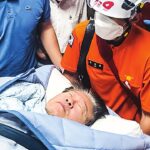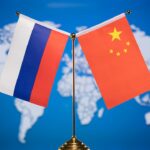China will steadily expand institutional opening-up, deepening trade and investment cooperation with ASEAN, and jointly promoting regional economic integration, Chinese Vice Commerce Minister Li Fei said on Sunday at the thematic side event of the ongoing China-ASEAN Expo under the theme of “institutional opening-up for new regional economic growth.”
Li noted that China will reasonably reduce the negative list for foreign investment access with other measures to elevate the liberalization and facilitation of trade and investment.
In terms of cooperation with ASEAN, Li said that China will deepen traditional trade by means such as increasing agricultural imports and expanding investment scale through channels like the New International Land-Sea Trade Corridor, while further exploring cooperation potential in emerging sectors such as the digital economy.
Li said that China is willing to work with ASEAN to accelerate negotiations for the Version 3.0 China-ASEAN Free Trade Area (FTA) and strive to reach an early conclusion, while jointly implementing the Regional Comprehensive Economic Partnership (RCEP) agreement and starting the accession process for new members as soon as possible.
Multiple achievements for this thematic side event were revealed on Sunday, such as the establishment of a China-ASEAN standardization cooperation and exchange center.
China has become an important participant and leader in international standardization, providing Chinese solutions in the fields of new-energy technology, electric vehicles and other industries, so strengthening cooperation between China and ASEAN in the field of international standardization is of great significance and a very urgent task, Shu Yinbiao, the 36th president of the International Electrotechnical Commission, said at the forum.
Experts highlighted institutional opening-up as a major growth point for China-ASEAN cooperation with more potential to be explored in multiple industries and sectors. Proposals from the Chinese Ministry of Commerce (MOFCOM) will promote economic integration, especially as the US and its Western allies are aiming to build a global supply chain excluding China and shifting industrial chains to Southeast Asia, they said.
Institutional opening-up is a new platform and mechanism of addressing various specific issues where it can contribute to better cooperation between China and ASEAN, Suriyan Vichitlekran, executive director of the Mekong Institute, told the Global Times on the sidelines of the forum on Sunday.
Vichitlekran said the institutional opening-up initiative has good intentions to lay down a mechanism at the operational level, but “it’s equally important that we need to bring other stakeholders, particularly the private sector in industry, so that they know they can actually benefit from this new mechanism, and provide recommendation for refining and improvement.”
The proposals by the MOFCOM will help arrange negotiations and deployments tackling potential challenges for progressing bilateral cooperation especially in trade and technology amid a complex geopolitical environment, said Chen Xiangmiao, director of the World Navy Research Center at the National Institute for South China Sea Studies.
For instance, the new-energy industry will be a focal point as China has advantages in aspects such as equipment manufacturing and research and development (R&D) in the global market. China and ASEAN will have to target further opening up the market against the backdrop of increasingly fierce global competition and Western interference, Chen told the Global Times on Sunday.
As for the highly anticipated Version 3.0 China-ASEAN FTA, a major highlight for this year’s expo, observers expect the 3.0 version to concentrate on deepening cooperation in emerging industries, and industrial divisions revolving around regional development.
The construction of the Version 3.0 China-ASEAN FTA will cover sectors such as the digital economy, green economy and supply chain connectivity, while complementing the construction of the RCEP and attracting investment from more multinational corporations outside the pact, said Xu Ningning, executive president of the China-ASEAN Business Council, the people.cn reported.
The 3.0 version will explore emerging areas such as data protection and open data in the digital economy field and new-energy vehicles and batteries for the green economy, Xu Liping, director of the Center for Southeast Asian Studies at the Chinese Academy of Social Sciences, told the Global Times on Sunday.
Chen added that China and ASEAN may deal with overlaps in the industrial structure while facing competition from the West, and the 3.0 version will focus on industrial division for the region’s development.
The R&D process and actual manufacturing could be distributed among different countries and regions based on the strength of each place, Chen said, adding that it will elevate the regional integration with upgrading and transformation for exchanges of personnel and production factors.
The Version 1.0 China-ASEAN FTA was established in 2010 after 10 years of hard work, with zero tariffs on trade in goods covering more than 90 percent of the products in the tariff lines of both sides, while the upgrading of Version 2.0 was implemented in 2019, with both sides further opening up their markets, according to the report from people.cn. Negotiations on version 3.0 were launched in November 2022.
Official data showed that bilateral trade increased from about $100 billion in 2004 to $975.34 billion in 2022. China has been ASEAN’s largest trading partner for 14 consecutive years, while ASEAN has been China’s largest trading partner for three consecutive years, the Xinhua News Agency reported.
(Global Times)




